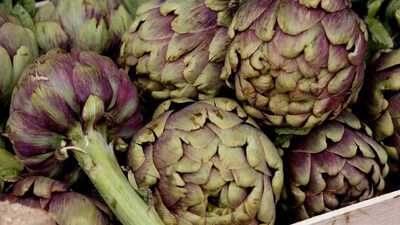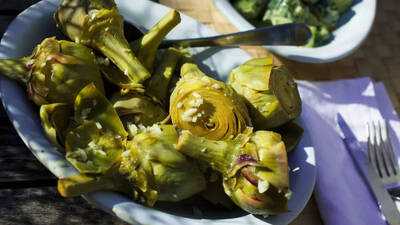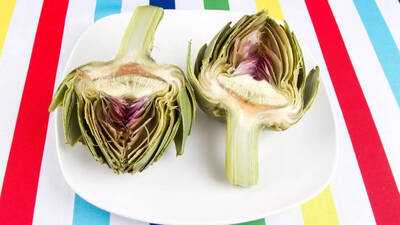With their tough, spiky leaves, artichokes might seem intimidating. But don’t let the exterior fool you, beneath that rugged shell lies one of the most satisfying, nutrient-rich vegetables you can eat. Packed with antioxidants, fiber, and vitamins C, K, and folate, artichokes are as good for your body as they are for your taste buds.
Technically, artichokes are thistle-flowering plants known for their prickly leaves and resilience. But here’s the catch: while they’re usually cooked whole, only a portion of the artichoke is actually edible.
So, before we even talk about cooking, let’s break down what you can eat and what you can’t.
Most of each leaf is fibrous and inedible. But at the very base? There’s a soft, fleshy bite you can scrape off with your teeth. The outermost leaves are the toughest; it gets more tender the deeper you go.

Located at the very center, right under the choke, the artichoke heart is soft, flavorful, and completely edible. If you've ever eaten marinated artichoke from a jar, this is the part you've had.
The choke—right above the heart—is inedible and must be discarded before eating.
The outer leaves are mostly tough and stringy; they're often bitter and typically discarded.
How to pick the right artichoke?
Not all artichokes are created equal. You need to judge one on the basis of two categories- color and firmness. Your ideal artichoke will be bright green, but if you find purple spots, don't be alarmed; they are normal. However, avoid anything with brown spots or leaves that are beginning to open or wilt. And lastly, the more tightly packed the leaves, the fresher the artichoke.
Size is not the issue, but keep in mind: they’ll also take longer to cook.
 How to prep an artichoke
How to prep an artichoke
For this, you don't need any fancy equipment. A sharp knife, a pair of kitchen shears, and some lemon juice will do.
Chop the stem: Cut the stem off flush with the base.
Lop off the top: About 1 inch from the top of the bulb—right where it starts to taper—slice it off cleanly.
Pluck & trim: Remove any tiny, dark outer leaves near the base. Use kitchen shears to snip the pointy tips from the remaining outer leaves (about ⅓ inch).
Rinse: Run the artichoke under cold water, gently pulling the leaves apart a little to rinse out any grit or dirt hiding inside.
Prevent browning: If you’re not cooking them right away, let them sit in acidulated water (a bowl of water with lemon juice) to prevent them from turning brown.

The easiest way to cook any artichoke?
Neither baking nor boiling—steaming is the most foolproof way to get a tender, flavorful artichoke without losing its essence.
Technically, artichokes are thistle-flowering plants known for their prickly leaves and resilience. But here’s the catch: while they’re usually cooked whole, only a portion of the artichoke is actually edible.
So, before we even talk about cooking, let’s break down what you can eat and what you can’t.
Most of each leaf is fibrous and inedible. But at the very base? There’s a soft, fleshy bite you can scrape off with your teeth. The outermost leaves are the toughest; it gets more tender the deeper you go.
Located at the very center, right under the choke, the artichoke heart is soft, flavorful, and completely edible. If you've ever eaten marinated artichoke from a jar, this is the part you've had.
The choke—right above the heart—is inedible and must be discarded before eating.
The outer leaves are mostly tough and stringy; they're often bitter and typically discarded.
How to pick the right artichoke?
Not all artichokes are created equal. You need to judge one on the basis of two categories- color and firmness. Your ideal artichoke will be bright green, but if you find purple spots, don't be alarmed; they are normal. However, avoid anything with brown spots or leaves that are beginning to open or wilt. And lastly, the more tightly packed the leaves, the fresher the artichoke.
Size is not the issue, but keep in mind: they’ll also take longer to cook.
For this, you don't need any fancy equipment. A sharp knife, a pair of kitchen shears, and some lemon juice will do.
Chop the stem: Cut the stem off flush with the base.
Lop off the top: About 1 inch from the top of the bulb—right where it starts to taper—slice it off cleanly.
Pluck & trim: Remove any tiny, dark outer leaves near the base. Use kitchen shears to snip the pointy tips from the remaining outer leaves (about ⅓ inch).
Rinse: Run the artichoke under cold water, gently pulling the leaves apart a little to rinse out any grit or dirt hiding inside.
Prevent browning: If you’re not cooking them right away, let them sit in acidulated water (a bowl of water with lemon juice) to prevent them from turning brown.
The easiest way to cook any artichoke?
Neither baking nor boiling—steaming is the most foolproof way to get a tender, flavorful artichoke without losing its essence.
- Fill a large pot with a few inches of water. Bring it to a boil.
- Place the prepared artichokes, cut-side up, in a steamer basket or colander over the water.
- Cover with a lid, reduce heat to a simmer.
- Steam for 40 to 60 minutes. Check occasionally. When an outer leaf pulls off easily, you’re done.
- Let them cool until you can handle them comfortably.
You may also like

Young mum quoted £600 for basic gardening job gets surprise of life

BHU Internship 2025: Apply Now for Dr. Sarvepalli Radhakrishnan Internship – Earn ₹20,000 Monthly Stipend

The Open: Scheffler holds 4-shot lead at Royal Portrush, inches closer to victory

'Need to cooperate with other parties ...': Shashi Tharoor's 'nation first' message amid Congress rift buzz; quotes Nehru

Double discount on SIM deals gets mobile shoppers cheap data and £168 cashback






